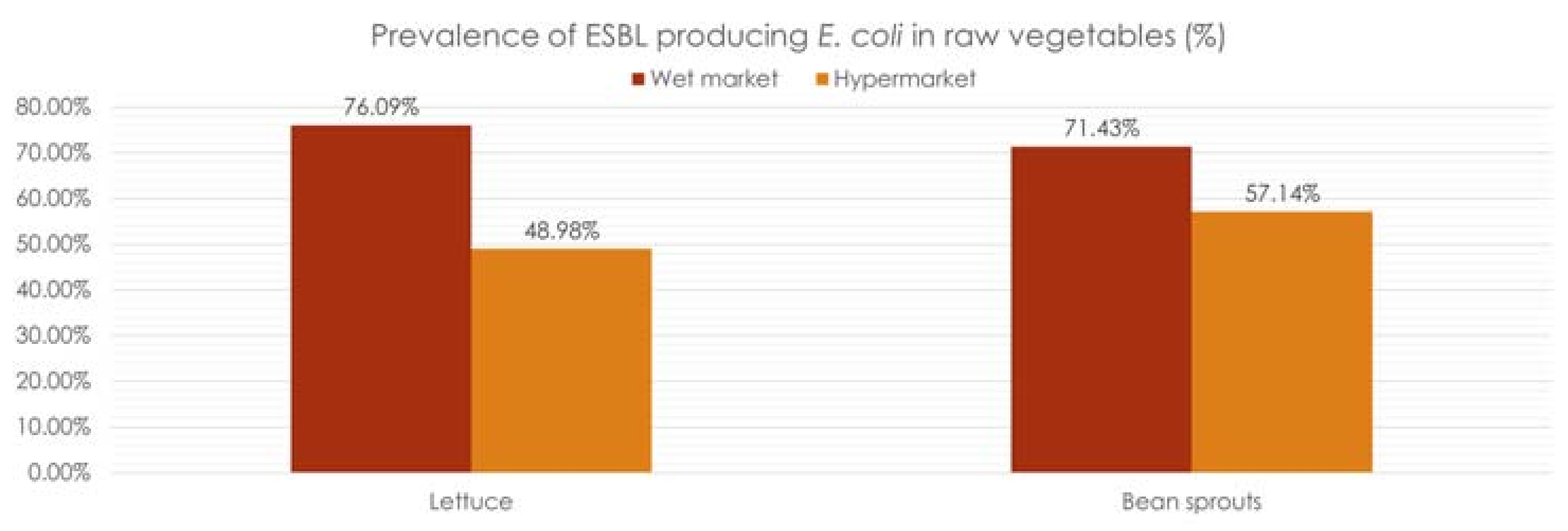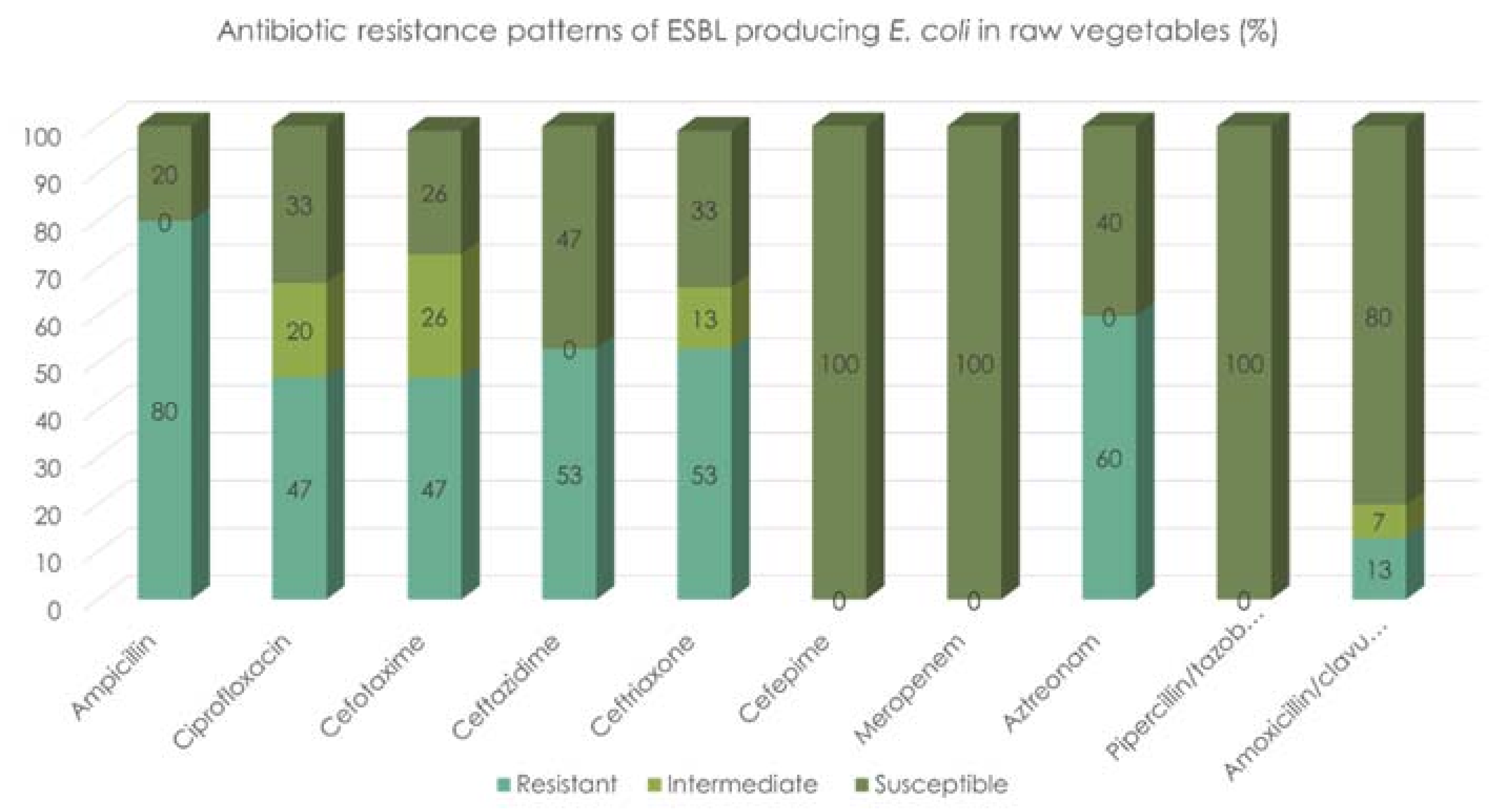Prevalence and Antibiogram Profiling of Extended-Spectrum Beta-Lactamase (ESBL) Producing Escherichia coli in Raw Vegetables, in Malaysia †
Abstract
:1. Introduction
2. Materials and Methods
2.1. Sample Collection
2.2. Most Probable Number and Polymerase Chain Reaction (MPN-PCR)
2.3. Antibiotic Susceptibility Test (AST)
3. Results and Discussion
4. Conclusions
Author Contributions
Funding
Institutional Review Board Statement
Informed Consent Statement
Data Availability Statement
Conflicts of Interest
References
- Mritunjay, S.K.; Kumar, V. Fresh Farm Produce as a Source of Pathogens: A Review. Res. J. Environ. Toxicol. 2015, 9, 59–75. [Google Scholar] [CrossRef]
- CLSI (2017); CLSI M100 Performance Standards for Antimicrobial Susceptibility Testing. 27th ed. Clinical and Laboratory Standard Institute: Pittsburgh, PA, USA, 2017.
- Reuland, E.A.; Al Naiemi, N.; Raadsen, S.A.; Savelkoul, P.H.M.; Kluytmans, J.A.J.W.; Vandenbroucke-Grauls, C.M.J.E. Prevalence of ESBL-producing Enterobacteriaceae in raw vegetables. Eur. J. Clin. Microbiol. Infect. Dis. 2014, 33, 1843–1846. [Google Scholar] [CrossRef] [PubMed]
- Reuland, E.A.; Al Naiemi, N.; Raadsen, S.A.; Savelkoul, P.H.M.; Kluytmans, J.A.J.W.; Vandenbroucke-Grauls, C.M.J.E. Geographic mapping of Enterobacteriaceae with extended-spectrum β-lactamase (ESBL) phenotype in Pereira, Colombia. BMC Infect. Dis. 2020, 20, 540. [Google Scholar]
- Loh, M.C.; Mamphweli, S.; Meyer, E.; Okoh, A. Antibiotic use in agriculture and its consequential resistance in environmental sources: Potential public health implications. Molecules 2018, 23, 795. [Google Scholar]


Disclaimer/Publisher’s Note: The statements, opinions and data contained in all publications are solely those of the individual author(s) and contributor(s) and not of MDPI and/or the editor(s). MDPI and/or the editor(s) disclaim responsibility for any injury to people or property resulting from any ideas, methods, instructions or products referred to in the content. |
© 2021 by the authors. Licensee MDPI, Basel, Switzerland. This article is an open access article distributed under the terms and conditions of the Creative Commons Attribution (CC BY) license (https://creativecommons.org/licenses/by/4.0/).
Share and Cite
Lee, E.; Radu, S.; Jambari, N.N.; Abdul-Mutalib, N.A. Prevalence and Antibiogram Profiling of Extended-Spectrum Beta-Lactamase (ESBL) Producing Escherichia coli in Raw Vegetables, in Malaysia. Biol. Life Sci. Forum 2021, 6, 44. https://doi.org/10.3390/Foods2021-10960
Lee E, Radu S, Jambari NN, Abdul-Mutalib NA. Prevalence and Antibiogram Profiling of Extended-Spectrum Beta-Lactamase (ESBL) Producing Escherichia coli in Raw Vegetables, in Malaysia. Biology and Life Sciences Forum. 2021; 6(1):44. https://doi.org/10.3390/Foods2021-10960
Chicago/Turabian StyleLee, Epeng, Son Radu, Nuzul Noorahya Jambari, and Noor Azira Abdul-Mutalib. 2021. "Prevalence and Antibiogram Profiling of Extended-Spectrum Beta-Lactamase (ESBL) Producing Escherichia coli in Raw Vegetables, in Malaysia" Biology and Life Sciences Forum 6, no. 1: 44. https://doi.org/10.3390/Foods2021-10960
APA StyleLee, E., Radu, S., Jambari, N. N., & Abdul-Mutalib, N. A. (2021). Prevalence and Antibiogram Profiling of Extended-Spectrum Beta-Lactamase (ESBL) Producing Escherichia coli in Raw Vegetables, in Malaysia. Biology and Life Sciences Forum, 6(1), 44. https://doi.org/10.3390/Foods2021-10960





